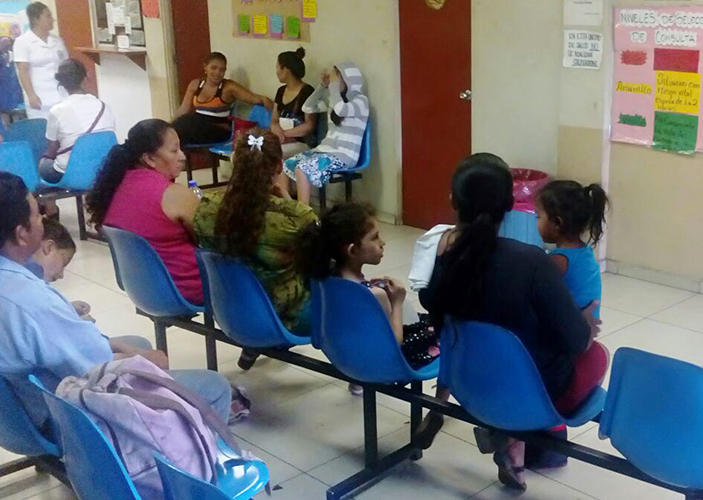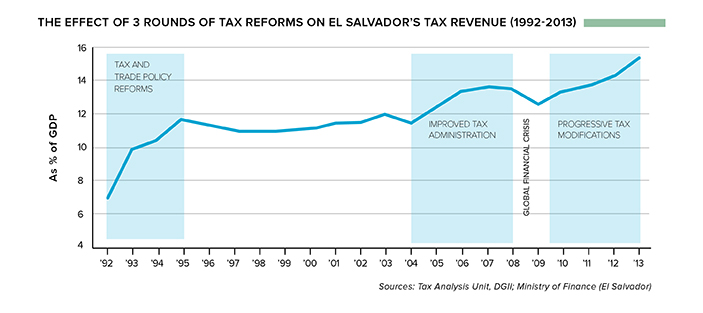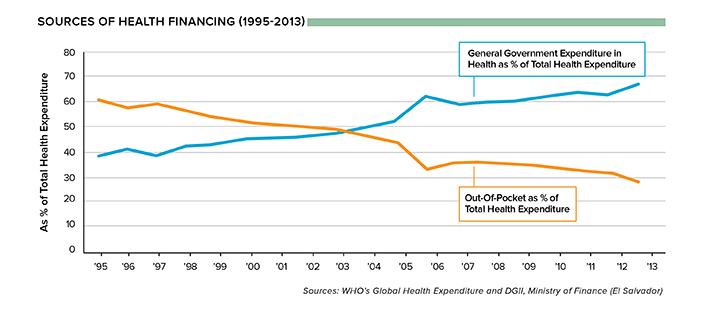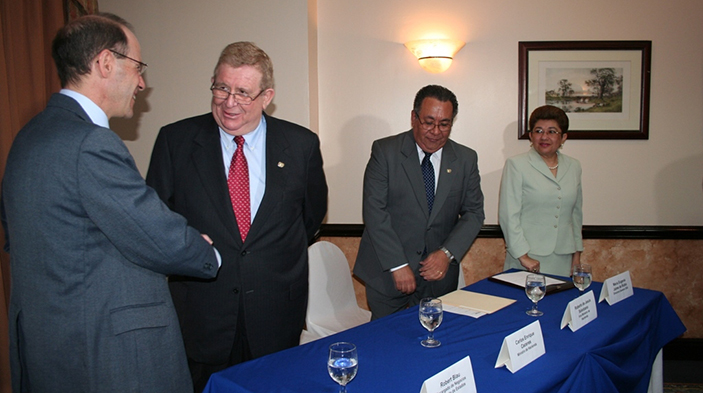DEVELOPMENTS
When Tax Reform Leads to Increased Funding for Health Services
Apr 14, 2016
For people across El Salvador, it can be difficult to find medical treatment. Local health facilities in marginalized and rural areas often run short of basic medicines such as antibiotics. A doctor or nurse—if available—might have difficulty locating supplies and tools such as syringes and stethoscopes. But this scenario is brightening.
El Salvador provides an important example of a developing country that reformed its tax system, increased tax revenues, and then prioritized expenditures toward key social programs, notably health care. Since the end of the civil war in 1992, El Salvador has almost doubled its percentage of tax revenue to gross domestic product (tax-to-GDP), from 8 percent in 1992 to almost 16 percent in 2015. This rise in the tax-to-GDP ratio reflects El Salvador’s effectiveness in collecting taxes more broadly and more fairly.
Over roughly the same period, the government’s health expenditures-to-GDP ratio rose from 2.4 to 4.6 percent in 2013, while individuals’ out-of-pocket health expenses steadily decreased. At the same time, Salvadorans’ life expectancy at birth increased from 66 to 72 years, while the under-5 mortality rate decreased from 59 to 16 per 1,000 live births.

Salvadorans endure myriad health challenges associated with poor countries, including undernourishment, dysentery, and communicable diseases such as dengue. Many citizens are casualties of violence related to gangs, drugs, and human trafficking. In recent months, the country’s latest mosquito-borne virus, Zika, is thought to have infected 6,000 people in this country of 6 million. In short, life for Salvadorans, especially the poor, can be fraught with uncertainty.
But by focusing on domestic revenue mobilization, the Government of El Salvador has provided a measure of stability to its citizens by significantly increasing spending on public health services—while improving service delivery.
Prioritizing Health Spending
Since 2003, El Salvador’s government has prioritized inclusive economic growth and poverty reduction, including improving key social services and expanding access to them. The 2004–2009 national development plan launched Plan de Oportunidades, aimed at improving public services in the poorest 100 municipalities, including increasing medical services available in local health units. The 2007 Law for the Creation of the National Health System sought to expand access and coverage, and required better coordination between government health institutions.

Between 2009 and 2014, the government launched a more comprehensive and longer-term National Health Policy, marking a new era for the sector. Priority actions included abolishing user fees for health, extending access to impoverished rural communities, stocking essential medicines and basic medical supplies in all government health facilities, and reorganizing the sector to tackle the fragmentation in government health services.
More recently, the 2010–2014 national development plan prioritized health financing in support of a broader social sector policy that addressed nutrition, education, and housing services delivered through Comunidades Solidarias. By 2013, 164 of the country’s 262 municipalities had benefitted from the reform program, expanding access to basic health services to 1.9 million Salvadorans from the poorest and rural municipalities.
Importantly, each of these health policies spawned initiatives that required increases in government funding, in both absolute and per capita terms.
Mobilizing Tax Revenue: Tax Policy and Administration Reform
Mobilizing domestic revenue in El Salvador resulted from three major tax reform efforts over two decades. Tax and trade policy reforms in the 1990s, including the introduction of a value added tax to replace the cascading sales tax, were complemented with modernization in tax and customs operations. Between 1992 and 1994, tax revenue as a percent of GDP rose from 7 to 11 percent.

Under a program funded by the U.S. Agency for International Development (USAID) and implemented by DAI, the second reform, beginning in the mid-2000s, improved tax administration. The General Internal Revenue Department introduced measures to improve fiscal compliance, mitigate fraud and corruption, improve tax awareness among youth, enhance taxpayer service, and increase the efficiency of administrative processes. It did so by automating core functions and modernizing the integrated tax administration system. Tax-to-GDP ratio further increased by nearly 2 percentage points to about 13 percent.
Beginning in 2011, the third reform included a package of progressive tax modifications, including raising the income tax rate and some excise tax rates, and eliminating exemptions. Another USAID/DAI fiscal reform program—the Fiscal Policy and Expenditure Management Program—accompanied initiatives to further modernize the tax administration system such as cleansing the taxpayer database, enhancing risk management through risk-based audit, and promoting timely filing and accurate reporting through pre-filed tax declarations. Enhancing tax collection systems and establishing a collection call center further contributed to the reduction of tax arrears.
This work produced impressive results. For example, the Government of El Salvador mobilized more than $300 million annually in additional tax revenue for expenditure on average from 2004 to 2011, without raising tax rates. Collectively, these reforms contributed to increasing tax-to-GDP from 12 percent in 2004 to close to 16 percent in 2015.
Impact on Health Spending
Political support in El Salvador for increased health spending is palpable, with the share of government spending on health rising alongside general government expenditures and GDP. While the proportion of health expenditure dipped from about 16 percent (2003–2007) to 12 percent (2009), it has since increased to more than 18 percent in 2013. El Salvador’s health spending as a share of the overall budget exceeded the Latin America regional average of 9.7 percent over the period 2005–2012 and 10.1 percent in 2013.

In addition to the health gains cited earlier, the increase in government health spending reduced individuals’ out-of-pocket expenditures. From 2003 to 2013, out-of-pocket spending per capita decreased from nearly $100 to $61, while government health spending per capita increased from $93 to $142. Government health spending increased as a share of total health spending from less than 40 percent in 1995 to 67 percent in 2013; this relieved the burden of out-of-pocket spending so that it fell from more than 60 percent to less than 30 percent of total health spending during the same period.

Next: Expenditure Reform
The relationship between tax-to-GDP and government health spending in El Salvador over the past 20 years demonstrates a positive relationship between the two—as tax-to-GDP rose, so did the value of government health spending. This trend reflects an increase in the government’s fiscal space combined with political prioritization of health. As a result, the country has witnessed improvements to health infrastructure, outpatient and inpatient care, and laboratories and blood banks, to name a few areas.
In making health a national political priority, El Salvador was able to pay for its promise to mobilize greater public resources through tax reform. Looking ahead, the government is sequencing tax reform with public expenditure reform initiatives. The implementation of a multiyear, results-based budget—with support from donors such as USAID, for example—is expected to emphasize public resource investment linked to the achievement of specific health targets and outcomes.
Sustaining the accomplishments thus far in domestic revenue mobilization will help maintain the government’s achievements in key sectors such as health, and perhaps finance improvements to health-related services such as sanitation and water in the not-too-distant future.